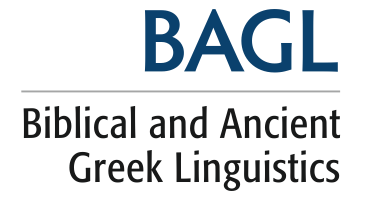7.1 | Paul L. Danove Villanova University, Villanova, PA, USA This article develops five features that describe the conceptualizations of
the event of communication grammaticalized by New Testament verbs and uses these
features to formulate a model of the observed New Testament usages of communication.
The discussion resolves all NT occurrences of verbs that designate communication
into one of twenty-one usages with distinct feature descriptions, offers guidelines
for interpreting and translating verbs with each usage, and clarifies elements of
the conceptualization of communication in relation to specific examples.
(Article) Keywords: Feature, communication, semantic, syntactic, verbal usage |
7.2 | Nicholas P. Lunn Wycliffe Bible Translators, High Wycombe, Buckinghamshire, UK The following aims to provide something lacking in the field of New Testament
Greek studies, which is an overview of the various forms in which the logical
relation of contrast may be realized in the surface structure of the language. Here
seven distinct categories are described, illustrated, and differentiated, with
regard to both their inherent relation and their respective connectors. Variations,
where such exist, within each basic category are included, along with any
sub-categories. A final section demonstrates the relevance of the presentation for
the related tasks of translation and exegesis, offering analyses of several texts
where there has been some confusion or misunderstanding with respect to the
contrasting relation. (Article) Keywords: Concession, replacement, exception, connector, translation |
7.3 | John J.H. Lee McMaster Divinity College, Hamilton, ON, Canada Ruqaiya Hasan’s Cohesive Harmony Analysis (CHA) is a useful tool to
quantifiably predict the degree of the reader’s perception of the coherence of an
English text. This work adopts and reconfigures her ideas to make them applicable to
ancient Greek texts. This article then applies the modified version of Hasan’s CHA
to investigate and compare the degrees of the perceived coherence of two family
letters written in the second century AD. Based on the textual analyses, the
conclusion is drawn that CHA is a promising tool to quantifiably predict the degree
of coherence of ancient Greek texts. (Article) Keywords: Cohesion, coherence, cohesive tie, cohesive chain, cohesive harmony analysis,
ancient Greek |
7.4 | Ryder A. Wishart McMaster Divinity College, Hamilton, ON, Canada This paper explores linguistic monosemy and the methodological priorities it
suggests. These priorities include a bottom-up modeling of lexical semantics, a
corpus-driven discovery procedure, and a sign-based approach to linguistic
description. Put simply, monosemy is a methodology for describing the semantic
potential of linguistic signs. This methodology is driven by the process of
abstraction based on verifiable data, and so it incorporates empirical checks and
balances into the tasks of linguistics, especially (though not exclusively) lexical
semantics. This paper contrasts lowest common denominator and greatest common factor
methodologies within biblical studies, with three examples: (a) Porter and Pitts’s
analysis of the semantics of the genitive within the Greek case system in regard to
the πίστις Χριστοῦ debate; (b) disagreement between Ronald Peters and Dan Wallace
regarding the Greek article; and (c) the Porter–Fanning debate on the nature of
verbal aspect in Greek. Analysis of the Greek of the New Testament stands to benefit
from incorporating the insights of monosemy and the methodological correctives it
steers toward. (Article) Keywords: Linguistic modeling, minimalism, traditional grammar, Saussure, Columbia
School, semantics |
7.5 | Stanley E. Porter McMaster Divinity College, Hamilton, ON, Canada In this paper, I revisit the question of the aspectual nature of the
imperative, or rather, examine the aspectual nature of imperatives and some other
forms that function alongside the imperative as forms of command and prohibition. I
divide my comments into three sections: imperatives and the Greek mood system,
verbal aspect and the imperative, and some abiding issues— three in particular—that
continue to be raised, despite the discussion that has transpired over the last
nearly thirty years. (Article) Keywords: Imperative, aspect, mood, frequency |
7.6 | Joseph D. Fantin Dallas Theological Seminary, Dallas, TX, USA Compared to other grammatical phenomena, the Greek imperative mood has
received minimal attention. This article will explore and evaluate the traditional
approach to the meaning and usages of this mood. These having been found deficient,
an alternate approach will be proposed. The imperative mood will indeed be found to
mean “command”; however, a “command” can be understood as harsh and inappropriate in
certain relational situations. It will be discovered that communicators use various
strategies to nuance and in some cases weaken the force of the “command” depending
on the intended purpose of the imperative and the relationships of the participants
in a communication situation. Thus, degree of force is one way (among others) to
classify an imperative. (Article) Keywords: Imperative mood, command, neurocognitive stratificational linguistics,
relevance theory |
7.7 | James D. Dvorak Oklahoma Christian University, Edmond, OK, USA This article discusses the semantics of the imperative mood (directive
attitude) in biblical Greek. The author leads into this discussion by first defining
“semantics” (meaning) from the perspective of two major interpretive paradigms that
are operative in current linguistic studies of biblical Greek: the
logical-philosophical paradigm, which undergirds Chomskyan linguistic theory, and
the ethnographic-descriptive paradigm, which lies behind Hallidayan Systemic
Functional Linguistics. The semantics of the imperative mood is then discussed from
each of these perspectives, and it is argued that an SFL approach to the imperative
is the most linguistically defensible. Examples are provided from the New Testament.
(Article) Keywords: Systemic functional linguistics, SFL, context, context of culture, context of
situation, semantics, directive attitude, imperative mood, command |

